
Instagram Evergreen: Japan’s Top 10 World Heritage Sites and National Treasures!
- Written by: Lucio Maurizi
Japan is an increasingly popular tourist destination for visitors from all over the world. In fact, by 2020, the country is aiming for 40 million tourists! The country offers more beautiful landmarks than one could visit in a lifetime, as well as culture, tradition, innovation, great food, and entertainment.
Japan is also home to a number of National Treasures and globally recognized UNESCO World Heritage Sites scattered all over its territory. These locations are gorgeous, and are all worth visiting. But time is always running against you when you're visiting Japan, and it can be tough to choose what to add to your itinerary. So to help you make your choice, we compiled a list of the most popular UNESCO World Heritage Sites in Japan, according to number of photos on Instagram, as well as the top 10 National Treasures!
About Japan’s National Treasures and UNESCO World Heritage Sites
The Japanese Agency for Cultural Affairs selected some of the tangible properties of Japan as national treasures, designating them as the most precious among all properties for their artistic, cultural, or historical value.
National treasures can belong to fine arts and crafts (sutras, paintings, ancient writings, swords, armors, books, etc.), or structures: Castles, Shrines, Temples, Residences, or Miscellaneous buildings. In this article, we have included national treasures belonging to the structures subcategory only - which can all be visited by tourists.
So what is a World Heritage Site? In short, a world heritage site is a landmark, or a whole area selected by the United Nations Educational, Scientific and Cultural Organization (UNESCO) as having cultural, historical, or scientific importance and as protected by international treaties.
These sites are all unique for their geographical characteristics, or for what they represent as a remarkable human achievement.
Japan holds in its territory 22 World Heritage sites. Although within them there are many structures classified as heritage sites themselves, making the list even longer – all the individual locations themselves include a total of just over 100 spots.
As you can see trying to see all the treasures and heritage sites of Japan in one visit (or even a few) would be nearly impossible, so we made your life easier and cross referenced them to the most popular (by number of tagged photos) among them on Instagram.
And now let's dive in!
Top 10 Japanese UNESCO World Heritage Sites on Instagram
10 – Kumano Kodo (Part of the Sacred Sites and Pilgrimage Routes in the Kii Mountain Range) - Wakayama, Nara, Mie Prefectures
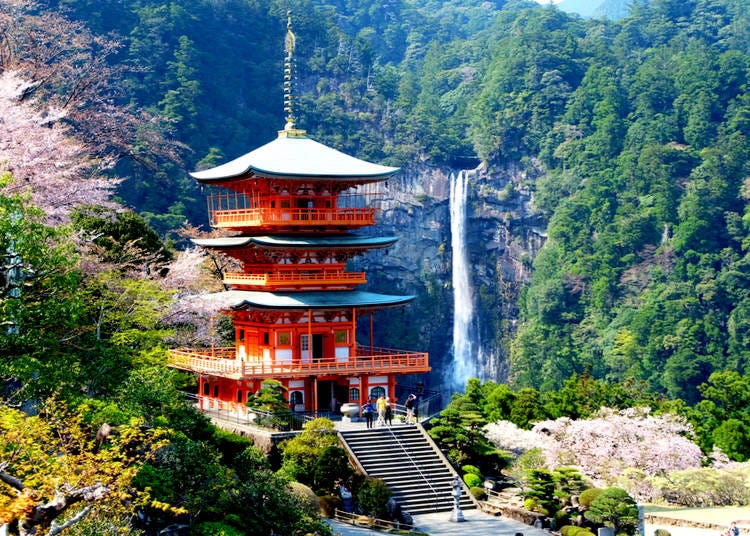
Kumano Kodo refers to a network of pilgrimage trails in the Kii Peninsula in the Kansai region. These routes have been in use for over a millennium and they lead to Kumano Sanzan, the Three Kumano Shrines – Hongu Taisha, Hayatama Taisha, Nachi Taisha.
Of the old trails, a few remain and are still used. The pilgrimage was intended to be an almost mystic experience in itself, and, while often hard and even dangerous, it took pilgrims through marvelous nature and amazing sights. Nowadays most of the peril in the trails has disappeared, but the contact with nature and its raw beauty remain.
9 – Tenryū-ji (Part of the Historic Monuments of Ancient Kyoto) – Kyoto
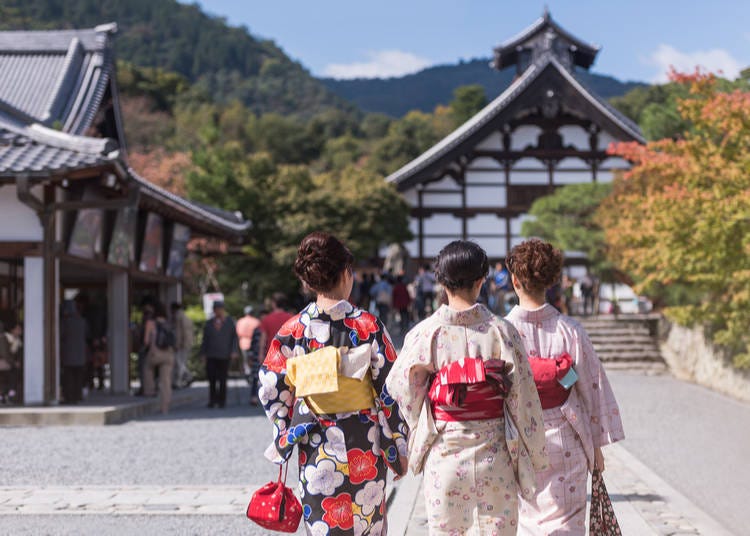
Immersed in the beautiful nature of the famous Arashiyama district in Kyoto Tenryū-ji is the head temple of Rinzai Zen, a sect of Japanese Buddhism.
The temple was originally built in 1339, but several parts of it were lost throughout the centuries to natural disasters and fires, and a lot of it was rebuilt during the Meiji Era.
What has survived the centuries is its breathtaking garden, surrounded by the forested Arashiyama mountain range.
By visiting the temple you will see reproductions of ancient halls (as well as original structures) and a sight to behold different in every season, in the temple's garden.
8 – Itsukushima Shrine – Hiroshima
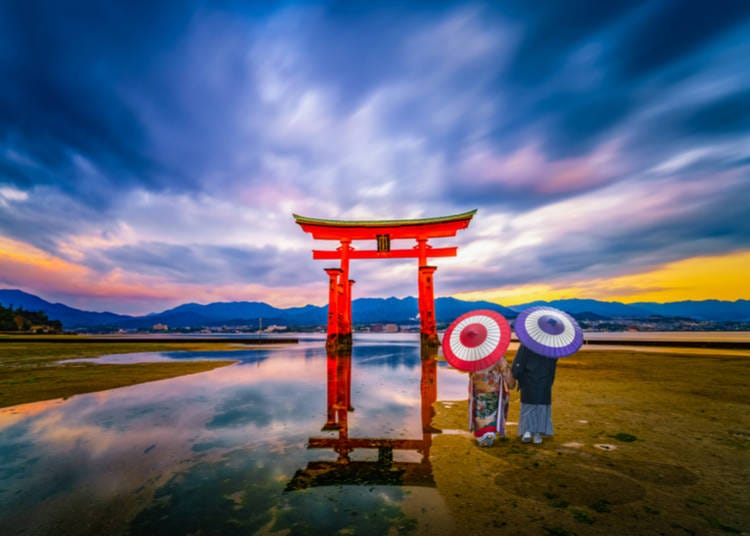
The Itsukushima Shrine is one of the most recognizable images of Japan and it belongs to both the World Heritage Sites list and the National Treasures one. The shrine and its torii gate are built in the water, which awarded them the nickname of "floating shrine".
Visitors can walk around the shrine and enjoy the view using wooden paths, or joining one of the many boat tours. While beautiful during the day, Itsukushima Shrine becomes magical at night, when its many suffused lights give it a fantastic aura.
7 – Nijo Castle (Part of the Historic Monuments of Ancient Kyoto) – Kyoto
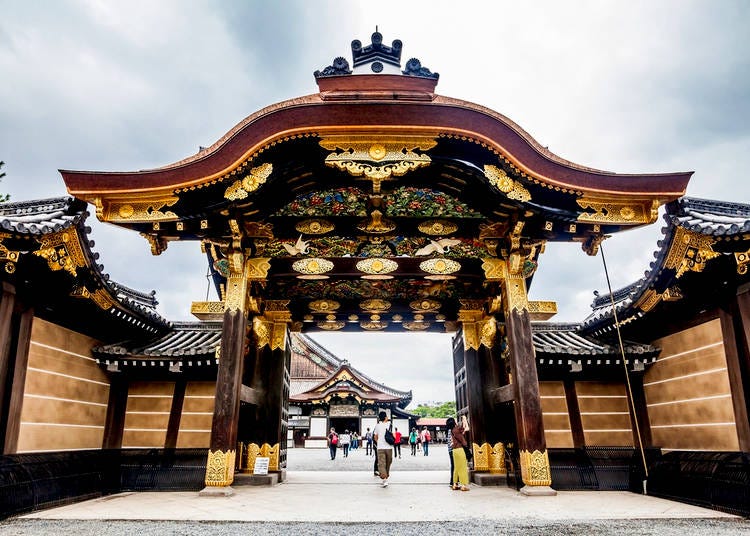
Nijo Castle is a masterpiece of Japanese architecture. The castle perfectly espouses beauty and power. Nijo Castle is a fortified structure built in 1603 by Tokugawa Ieyasu, the first of the shogun of the Edo period. It was later expanded by his grandson.
The two main areas of the castle, Honmaru and Ninomaru (main circle and secondary circle of defense) are surrounded by a gorgeous green area with hundreds of cherry trees, as well as trees of other varieties. The palace sitting within the Ninomaru section is always open to the public, but the Honmaru Palace opens only during special occasions. Nijo Castle is one of the must-see landmarks of Kyoto.
6 – Ginkaku-ji (Part of the Historic Monuments of Ancient Kyoto) – Kyoto

Ginkaku-ji (or Silver Temple/Silver Pavilion) is a Zen temple sitting on Higashiyama (Kyoto Eastern Mountains).
The temple was originally built in the 15th century as a residence for the shogun, modelled after Kinkaku-ji (The Golden Pavilion).
The grounds of Ginkaku-ji contain a beautiful moss garden, and a rare dry sand garden (The Sea of Silver Sand). The visit will take you through numerous tree-coasted paths to other temples and shrines lurking through the lush vegetation.
5 – Yakushima – Kyushu
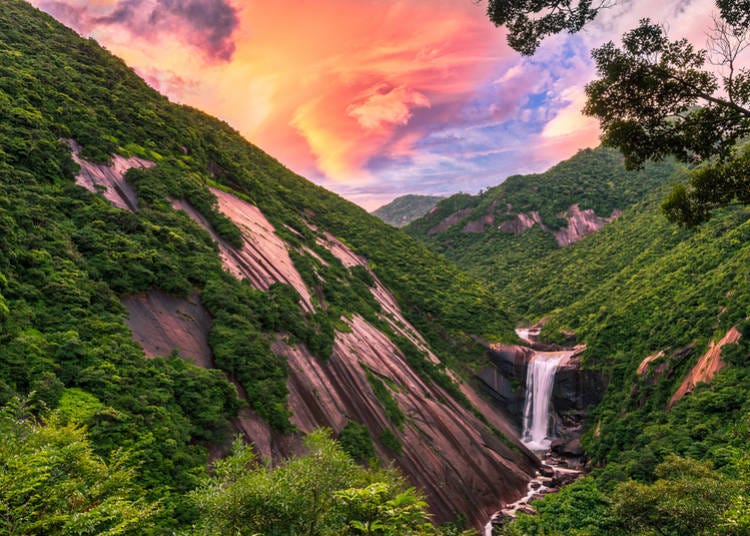
Yakushima is an island off the southern coast of Kyushu, in Southern Japan.
The island is covered by a dense forest of ancient trees (about 1000 years old, with the oldest one estimated to be 7000 years old).
Today the forest is a breathtaking national park and a hiker's paradise. But make sure to pack your raincoats. Yakushima is a tropical island with frequent rains: locals joke about it having 35 days of rain a month.
4 – Himeji Castle – Hyogo
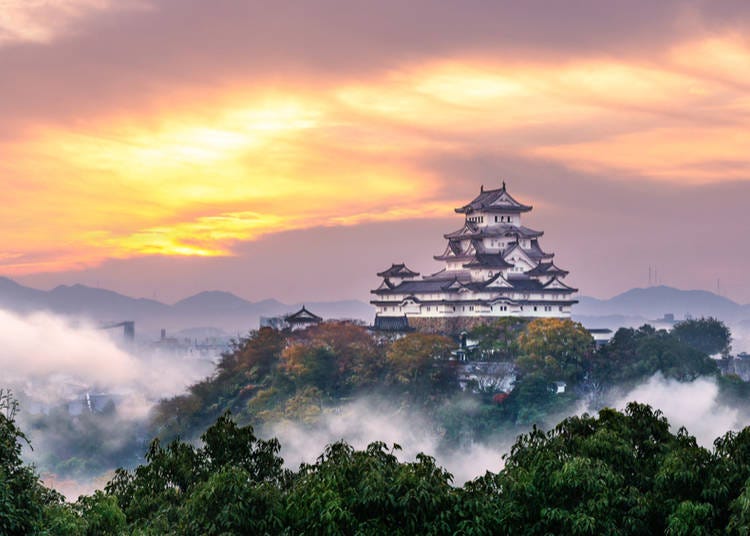
Himeji Castle is both a World Heritage Site and a national treasure. It's one of the 12 original Japanese castles. In fact, unlike many other castles in Japan, it was never destroyed during war or by natural disasters. Its main fortifications were built in the 15th century as protection for the, at that time, capital city of Kyoto, but it was finished building as we see it today, in 1609.
Himeji Castle is also one of the most popular spots in Japan to admire cherry blossoms. Its paths leading among the walls to the main castle, once meant to slow down potential attackers, today offer a great tour of the outside grounds of the castle.
The site underwent years of restorations, but now visitors can enjoy also its inner grounds and indoor areas.
3 – Kinkaku-ji (Part of the Historic Monuments of Ancient Kyoto) – Kyoto

Also known as the Golden Pavilion, or Golden Temple, Kinkaku-ji is a feat of fantasy novel – like architecture.
This Zen temple derives its name from the gold sheets that cover its two-story structure.
Kinkaku-ji is built in the middle of, and overlooking a calm pond, surrounded by a beautiful garden worth visiting in every season - although it makes for Instaworthy pictures when the pavilion is layered with snow.
Inside the temple rest the statues of Shaka Buddha and of the shogun Ashikaga Yoshimitsu, who used the temple as his retirement villa. The Pavilion grounds are not accessible, but the statues are visible from the garden surrounding the temple.
2 – Shirakawago and Gokayama – Gifu
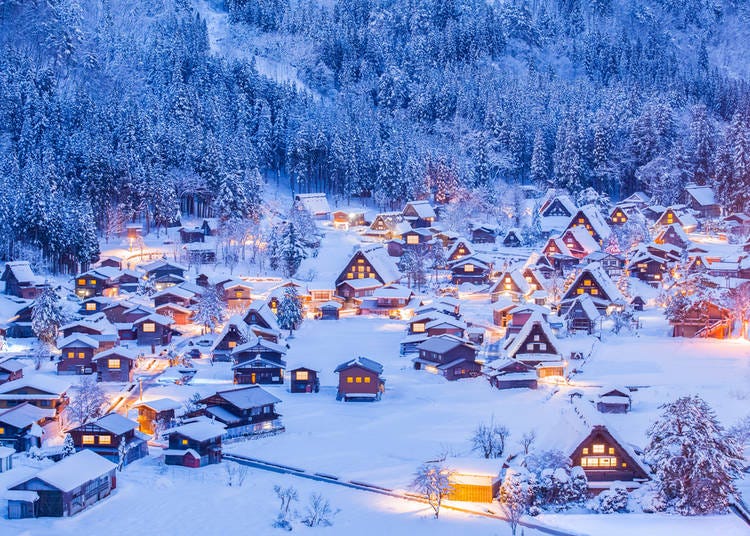
For those of you who enjoy spending time in beautiful landscapes and sights (especially in winter), it will be hard to pass on these areas. These regions, which have been listed as UNESCO World Heritage Sites since 1995, are famous especially for their traditional thatched-roof houses, some of which are centuries old.
In Shirakawago you can visit many villages (the most popular of which is Ogimachi) in a peaceful and quiet setting. What's more, you can truly get the best out of your stay by lodging in one of the many minshuku, traditional, family run, Japanese-style bed and breakfasts.
If you're feeling more adventurous and want to see some of the county's most uncontaminated locations, take a trip to Gokayama. Its many villages are virtually untouched by large modern buildings and offer a truly unique experience.
1 – Mount Fuji
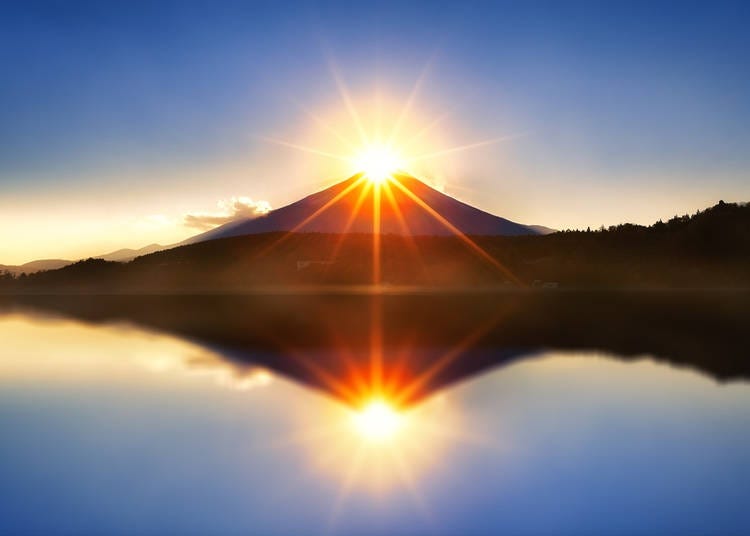
Fujisan, as it's called in Japan, is the highest peak in the country. This active volcano is one of the most easily recognizable images linked to Japan with its shape that seems painted on a canvas in the background.
Mount Fuji is one of the three sacred mountains of Japan (alongside Mount Hako and Mount Tate) and millions of visitors from all over the world enjoy its sight and the beauty of the surrounding areas all year round.
You can climb Mt. Fuji between July and September, or visit some of the beautiful areas at its feet whenever you want.
Lake Kawaguchiko, one of the main lakes by Mt. Fuji, offers one of the most iconic views of the mountain, as well as a peaceful setting on the shores of the lake sitting in a large and gorgeous natural park. The area becomes especially fable-like in spring, not only for the many cherry trees blooming, but also for the host of other flowers and trees showing their colors.
Top 10 Japan National Treasures (Castles, Temples, Shrines, Residences)
10 – Kiyomizudera Temple – Kyoto
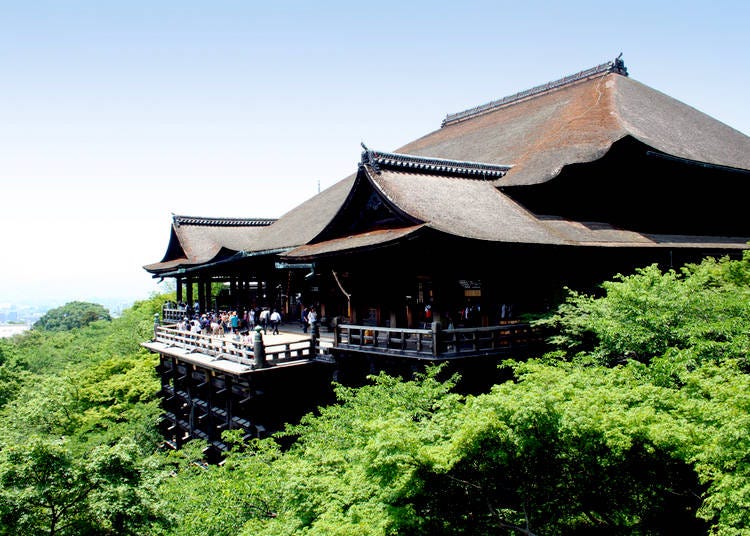
Kyomizudera is one of the most visited temples in Japan. Its namesake (lit. Pure Water Temple) derives from its having been built on the site of the Otowa Waterfalls. Kyomizudera offers unique views over Kyoto. Its large grounds include, aside from the beautiful main hall, a wooden stage overlooking the temple grounds and the woods surrounding it, and the Jishu-Jinja Shrine, dedicated to the deity of love and matchmaking. Visitors enjoy the temple especially in Spring, during the cherry blossoms season, and in Fall, with the leaf changing. In summer, like many other temples and shrines in the area, Kiyomizudera offers spectacular night-time illuminations.
9 – Kitano Tenmangu – Kyoto
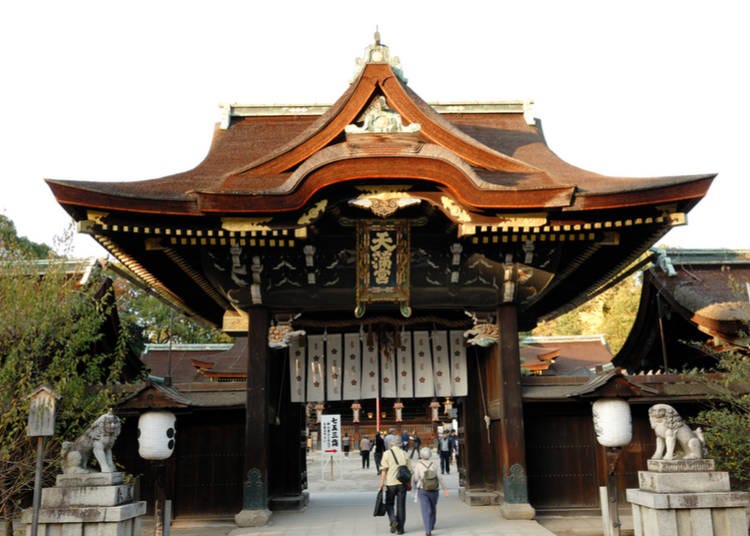
Kitano Tenmangu is one of the most important shrines in all of Kyoto. It rests in the middle of the most traditional and oldest geisha and maiko (geisha in training) district of the city, Kamishichiken. It’s especially famous for its plum trees (2000 of the most beautiful in Kyoto), and its monthly open-air market.
The shrine is associated to Tenjin, the Shinto god of education. Tenjin was believed to be the deification of a politician and poet who lived between 845-903AD, Sugawara no Michizane. Having been unjustly exiled from Kyoto by his political rivals, after his death, people believed his vengeful spirit was the cause of many disasters plaguing Japan. Kitano Tenmangu was one of the shrines built to appease Sugawara’s rage. The shrine was then decorated with plum trees, favored by Sugawara.
8 – Tofuku-ji – Kyoto
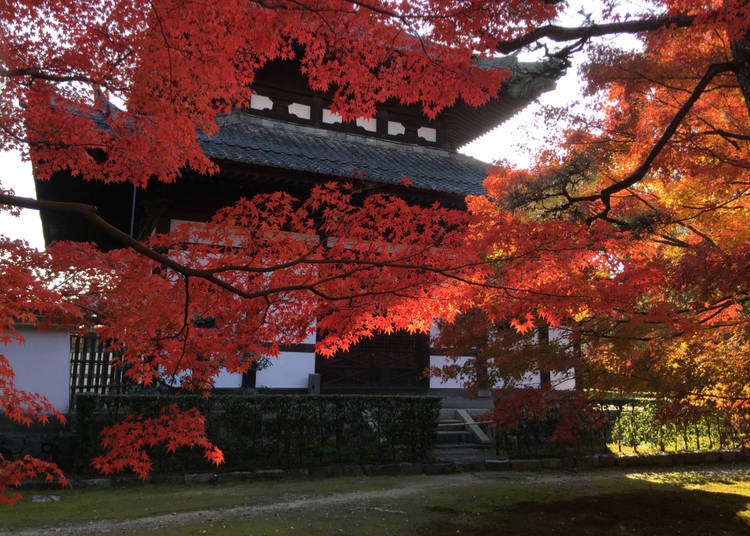
Tofuku-ji Temple is a large and gorgeous Zen temple in the former capital of Japan. Visitors can roam its grounds almost entirely, enjoying the many prayer rooms, the former head priest's sleeping quarters, as well as an amazing patio meant to contemplate while gazing at a perfectly maintained sand garden.
The temple presents some of the oldest examples of Zen architecture in its Sanmon Gate and in several of the smaller temples. Tofuku-ji is particularly popular in autumn, when the hundreds of maple trees that populate its gardens change colors and visitors can enjoy a relaxing walk among them on the temple's Tsutenkyo Bridge.
7 – Hasedera – Kamakura, Kanagawa
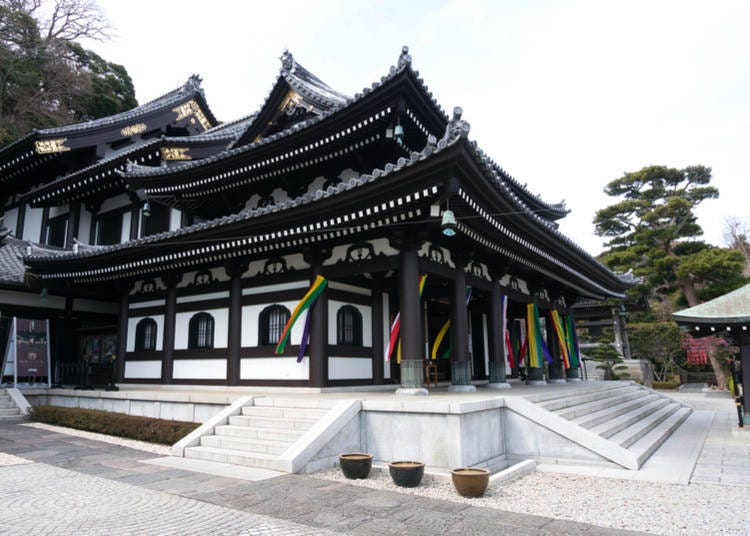
Hasedera (Hase Temple) is home to one of the largest wooden sculptures in Japan, the majestic 11-headed goddess of mercy, Kannon. The temple also has a museum in which visitors can view a number of Buddhist artefacts and treasures. The temple is a perfect setting to spend several hours, not only for its beautiful gardens and paths (it’s especially popular during early summer for hydrangeas), but also because it has within its grounds a small restaurant overlooking the sea which serves traditional food and sweets.
6 – Matsumoto Castle – Nagano
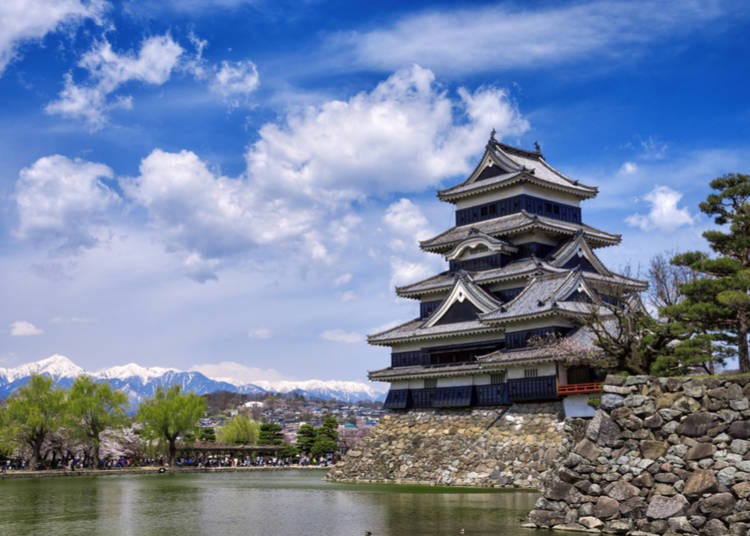
Matsumoto Castle is an amazingly preserved former fortress built on a plain still presenting its original fortifications and defenses, as well as much of its original wooden structures.
Visitors can stroll inside and outside the castle enjoying a unique experience in a structure that still maintains its original wooden frame and décor.
Matsumoto castle is also one of the favorite destinations in the region for hanami (cherry blossoms viewing).
5 – Bannaji Temple – Ashikaga, Tochigi
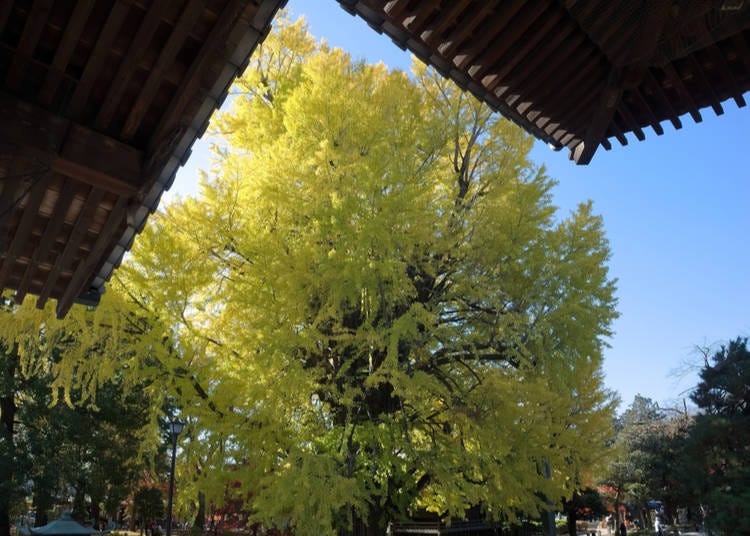
Bannaji is the most famous temple in the city of Ashikaga and it offers visitors a unique look at a one-of-a-kind sacred building. Bannaji is, in fact, intimately associated with the rise of the Ashikaga clan, which used to rule Japan between the 12th and 13th centuries.
Unlike other temples in Japan, Bannaji appears as a mix of sacred grounds and fortress. The temple is protected by a moat and a wall and accessible via a bridge that goes through the tower gate Yama-mon. The main sanctuary is a few minutes from the entrance overlooked by its famous 600 years old gingko tree. The large temple grounds have dozens of buildings visitors can see, as well as characteristic statues in the midst of a mystic and martial setting.
4 – Itsukushima Shrine – Hiroshima
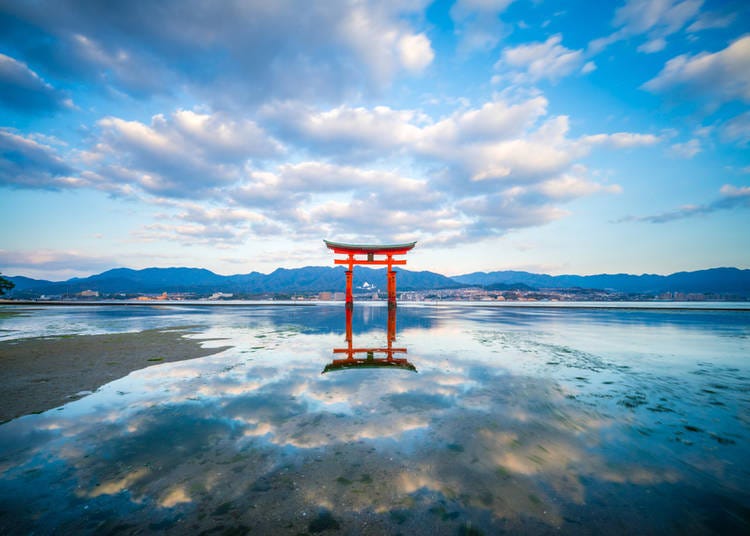
Itsukushima Shrine is one of the only two landmarks to make this list twice both as one of the most popular UNESCO World Heritage Sites and National Treasure.
Miyajima Island, the site where the shrine is located is a holy land of Shinto, worshipped since the 6th century, and this is why, in 1168, Taira no Kiyomori, the most powerful man in Japan at that time, selected this location to erect the Itsukushima Shrine. As mesmerizing as it is, the shrine is only the centerpiece of an equally beautiful landscape, inviting visitors to marvel at the bay surrounded by lush tall mountains.
3 – Nanzen-ji – Kyoto
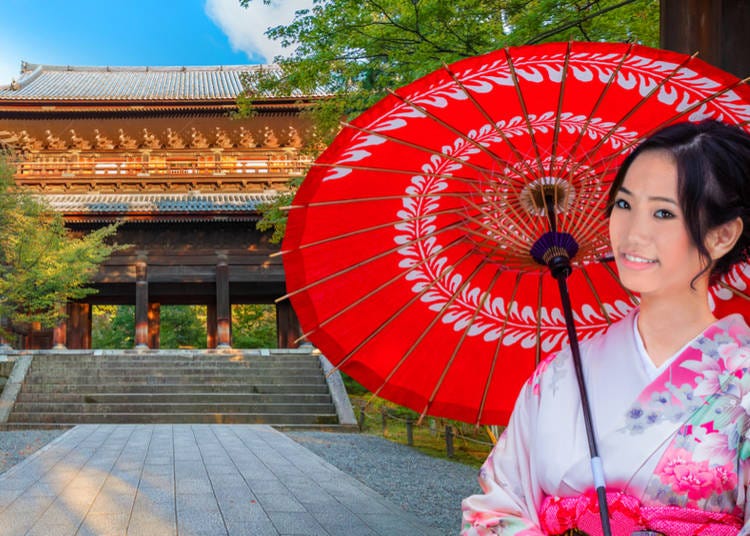
Nanzen-ji temple includes in its grounds a number of other temples creating a massive complex. The history of the temple is embedded within the history of Japan.
It was originally built as Emperor Kameyama's retirement villa in the 13th century, and later converted into a Zen temple. Its original buildings were all destroyed during the civil wars that raged between 1333 and 1573, but the temple was then rebuilt and it remains to this day.
The large gate at the entrance was built by the Tokugawa clan and it's possible to climb up to get a great view of the city.
While strolling through the grounds you'll stumble upon many buildings and will be able to visit most of the interiors, as well as enjoy gorgeous gardens and ponds.
A truly unique feature of Nanzen-ji is its brick aqueduct, resembling ancient Roman ones, built during the Meiji period to carry water and goods between Kyoto and Lake Biwa, in Shiga.
2 - Todai-ji – Nara
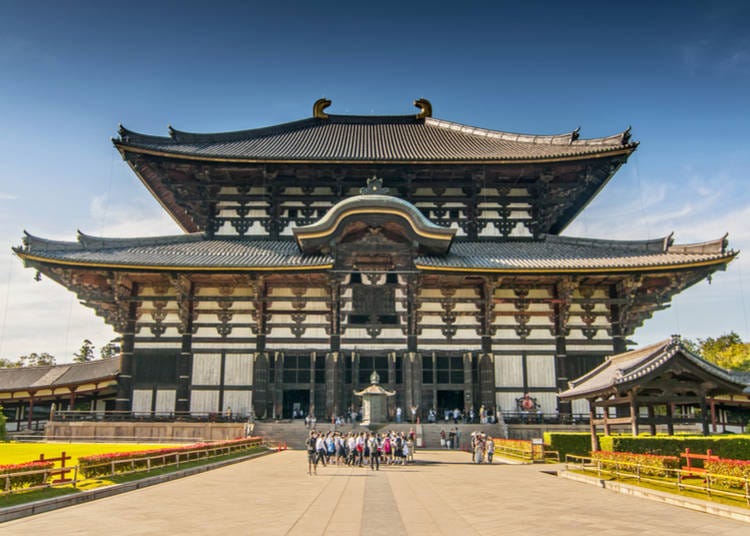
Todai-ji is one of the most important temples of Japan and it has been for centuries. Its name means "Great Eastern Temple" and since being erected in 752 it grew so powerful that the capital of Japan was moved to Nagaoka from Nara in an attempt to reduce its influence.
Its Daibutsuden (Great Buddha Hall) is the world's largest wooden building, and it houses the Daibutsu, Japan's largest Buddha's bronze statue.
The temple is nearby Nara Park and the deer that roam the city freely can be found entertaining visitors or minding their own business in the green of the beautiful park that leads from the main gate to the Daibutsuden.
In fall, with the foliage color changing, the maple trees surrounding the pond in the garden of the temple add a gorgeous crimson tone to the landscape making it a perfect setting for gorgeous pictures.
1 – Himeji Castle – Hyogo
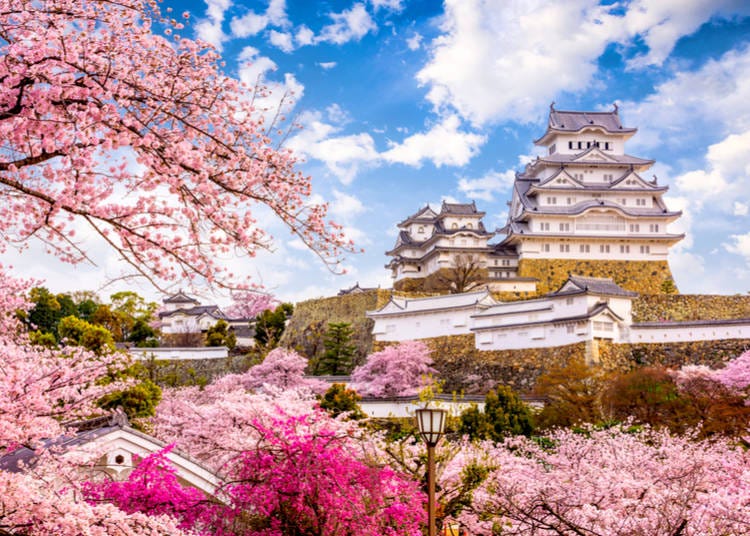
One of the most popular of Japan's UNESCO World Heritage Sites is also at the top of the list of the most popular National Treasures.
Upon visiting this landmark it's easy to see why. Not only is the castle arguably the best preserved one of its kind in Japan, but the amount of detail that is still present in its architecture is staggering. While walking among walls and gorgeous trees, you'll see original feudal family crests installed on the buildings and walls, giving you a tour of all the families and lords that have inhabited the castle.
Visitors can roam the castle's complex grounds comprising 83 among storehouses, gates, corridors and turrets. Of these, 74 are designated as important cultural assets in their own right.
Himeji Castle is a fortress that is also a piece of art and a feat of architecture and what's best is that tourists can visit it almost in its entirety.
Lucio Maurizi is an automotive expert specializing in Japan's car scene and auto-tourism. With an MA in East Asian History from La Sapienza Università di Roma, he's a multi-talented contributor to travel platforms like LIVE JAPAN, Japan Travel, and GPlus Media. His Instagram account (50k+ followers) offers insider views on Japan's automotive culture. Lucio also actively collaborates with professional drivers and influencers and organizes can't-miss car events in Tokyo.
*Prices and options mentioned are subject to change.
*Unless stated otherwise, all prices include tax.
Popular Tours & Activitiess
Recommended places for you
-

Naritasan Shinshoji Temple
Temples
Narita
-

Ueno Zoo (Ueno Zoological Gardens)
Zoos, Aquariums & Botanical Gardens
Ueno
-
Events

Tokyo Tower
Landmarks
Roppongi
-

TOKYO SKYTREE®
Landmarks
Ryogoku / TOKYO SKYTREE(R)
-

The Tokyo Station Marunouchi Building
Landmarks
Tokyo Station
-

Shibuya Crossing
Downtown
Shibuya
-
Ad

Discover the "Miraculous Forest" in the Heart of Tokyo: The Institute for Nature Study (9 Minutes from JR Meguro Station)
-
Ad

[Tokyo, Ueno] Journey to the Sacred Grounds of the Tokugawa Shoguns: Join the "EDO SHOGUN’S LEGACY TRAIL TOUR" – Where Special Access, Modern Art, and Digital Innovation Converge
by: Guest Contributor
-

New in Ginza! Air BicCamera Ginza Opens with a Faster, More Convenient Shopping Experience
by: Guest Contributor
-

When Will Cherry Blossoms Bloom in Japan? The 2026 Sakura Forecast You'll Want to Bookmark
-

Japan’s Shinkansen Is About to Change Travel in an Unexpected Way
by: Guest Contributor
-

This Winter, Godzilla Takes Over Haneda Airport
by: Guest Contributor
Inspiration for Accommodations
-

Enjoy Mt. Fuji from the Comfort of Your Room! Recommended Ryokan with Mt. Fuji View
-

Stay Near the Cherry Blossoms! Hotels for Cherry Blossom Viewing in Tokyo
-

Family-Friendly Hotels with Free Shuttle to Disneyland: Convenient Access for a Magical Stay
-

Top Ranked Hakone Hotels with Mt. Fuji View: Enjoy Stunning Scenery from Your Private Space
-

Convenient Tokyo Hotels with Airport Shuttle: Ideal for Families and Heavy Luggage
-

Stunning Tokyo Tower View Hotels: Enjoy Spectacular Scenery from Your Private Space
-

Convenient Asakusa Hotels with Kitchens: Ideal for Extended Family Visits
-

Experience Luxury: Hakone's 10 Best Five-Star Accommodations
-

Enjoy Mt. Fuji Autumn Leaves! Top Hotels Near the Popular Autumn Leaves Corridor
-

Experience Hakone Fall Foliage from Your Room with Stunning Views
-

Shibuya Crossing: Getting the Best View from the Deck at Magnet by Shibuya109!
-

JR Edition: Visit all of Tokyo in one Day with the Tokyo Metropolitan District Pass!
-

Guide to Tokyo's Old Quarter: 7 Quaint Spots in Yanesen!
-

An informative and engaging tour of Iwami Ginzan Silver Mine-a UNESCO World Heritage Site
-

Numazuko Kaisho in Ueno: Good Quality, All-You-Can-Eat Seafood for Just US$12!?
-

The Best of Japan: 11 Major Cities Every Traveler Should Visit
- #best ramen tokyo
- #what to buy in ameyoko
- #what to bring to japan
- #new years in tokyo
- #best izakaya shinjuku
- #things to do tokyo
- #japanese nail trends
- #what to do in odaiba
- #onsen tattoo friendly tokyo
- #daiso
- #best sushi ginza
- #japanese convenience store snacks
- #best yakiniku shibuya
- #japanese fashion culture
- #best japanese soft drinks













